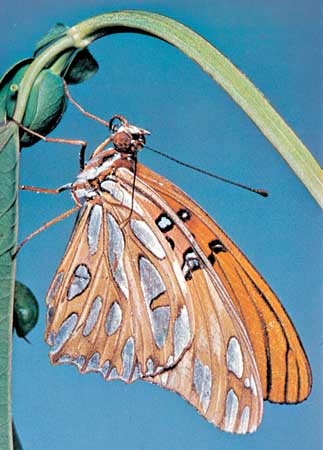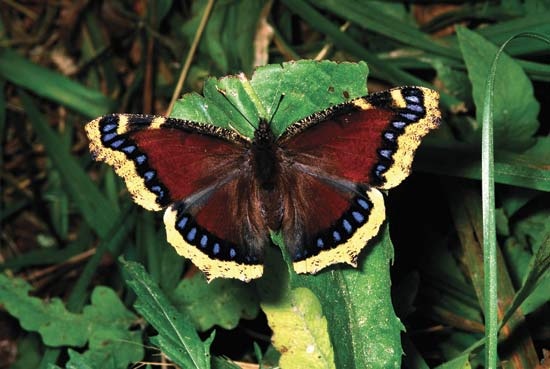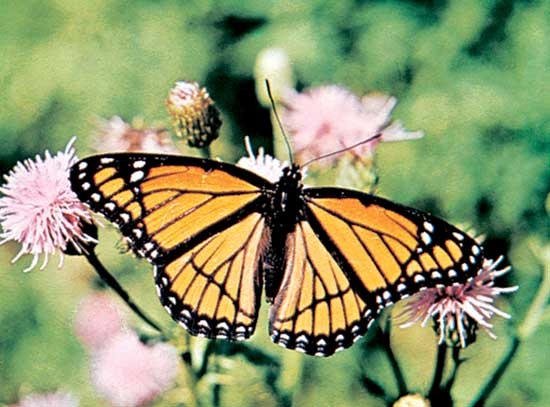brush-footed butterfly
insect
also called four-footed butterfly
 any of a group of butterflies (order Lepidoptera) that are named for their characteristically reduced forelegs that are frequently hairy and resemble brushes. The insects' alternative name derives from the fact that there are only four functional, or walking, legs.
any of a group of butterflies (order Lepidoptera) that are named for their characteristically reduced forelegs that are frequently hairy and resemble brushes. The insects' alternative name derives from the fact that there are only four functional, or walking, legs.Most species have a wingspan of 35–90 mm (1.5–3.5 inches) and white, yellow, or brown wings with contrasting markings and undersurfaces often with duller, more protective coloration. Common nymphalids include the anglewing, fritillary, mourning cloak, thistle, and viceroy butterflies. Most nymphalid larvae are brightly coloured and have knobby projections (tubercules), horns, and branching spines. The naked pupae, or chrysalids, hang head downward.
Adult anglewings show seasonal dimorphism, with the autumnal generation being hairy and lighter-coloured. Some also exhibit sexual dimorphism, with the female being less conspicuous than the male. Most species have a silvery spot on the undersurface of each hindwing. The spiny larvae feed on elm and birch trees, hops, and nettles.
The name fritillary is applied to several nymphalid genera. The large fritillaries, or silverspots, belong to the genus Speyeria and usually have silver markings on the undersides of the wings. Many of the smaller fritillaries are members of the genus Boloria. Many fritillary larvae are nocturnal and feed on violet leaves.
 The mourning cloak (Nymphalis antiopa), known as the Camberwell beauty in England, overwinter as adults. The larvae, often known as spiny elm caterpillars, are gregarious in habit and feed principally on elm, willow, and poplar foliage.
The mourning cloak (Nymphalis antiopa), known as the Camberwell beauty in England, overwinter as adults. The larvae, often known as spiny elm caterpillars, are gregarious in habit and feed principally on elm, willow, and poplar foliage.The thistle butterfly (Vanessa) is named for its principal larval host plant. Some species, such as the painted lady (V. cardui), migrate during adulthood, traveling in large groups.
 The viceroy (Basilarchia archippus, or Limenitis archippus) is known for its imitation of the monarch butterfly, which is distasteful to predators. Through this resemblance the edible viceroy, which can be distinguished by its smaller size and by a black transverse band on each hindwing, probably derives protection from predatory attack. Viceroy larvae feed on willow, aspen, and poplar foliage. Recent studies have suggested that in some areas both viceroy and monarch butterflies may be distasteful to predators.
The viceroy (Basilarchia archippus, or Limenitis archippus) is known for its imitation of the monarch butterfly, which is distasteful to predators. Through this resemblance the edible viceroy, which can be distinguished by its smaller size and by a black transverse band on each hindwing, probably derives protection from predatory attack. Viceroy larvae feed on willow, aspen, and poplar foliage. Recent studies have suggested that in some areas both viceroy and monarch butterflies may be distasteful to predators.- heliotrope
- heliozoan
- helium
- helium dating
- hell
- Hellabrunn Zoo
- Helland-Hansen, Bjørn
- Hellanicus of Lesbos
- hellanodikai
- Hellas
- Hella S. Haasse
- hellbender
- Hell Creek Formation
- hellebore
- helleborine
- Hellen
- Hellenistic Age
- Hellenistic religion
- Hellenistic romance
- Hellens, Franz
- zone of avoidance
- Zonguldak
- Zonheboto
- zoning
- zoo